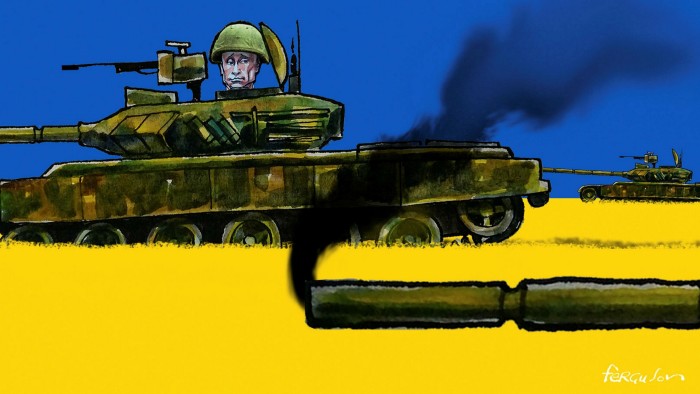How Putin took Europe to the brink of war


Simply sign up to the War in Ukraine myFT Digest -- delivered directly to your inbox.
Angela Merkel once described Vladimir Putin as a leader using 19th-century methods in the 21st century. What the former German chancellor meant was that Russia’s leader is a man of war and nationalism in an era supposedly defined by laws and globalisation.
Merkel was talking after Russia annexed Crimea in 2014. Now the US and British governments are warning that Putin is poised to start “the biggest war in Europe since 1945” by launching a much more extensive invasion of Ukraine, involving a direct assault on its capital, Kyiv.
This weekend, much of the western security and political elite was gathered in Germany for the Munich Security Conference. Alongside the tension and foreboding, one of the dominant emotions on display was simple incredulity.
Many diplomats and politicians, predominantly Europeans, still refused to believe the intelligence-based briefings pouring out of the Anglosphere. The sceptics’ view was broadly that fighting would remain confined to eastern Ukraine. They speculate that Putin’s goal is to build political, economic and psychological pressure to the point where the Ukrainian government collapses: or the west makes massive diplomatic concessions.
There is a different sort of incredulity among those who are convinced that Putin is about to “go big” and launch a full-scale, bloody invasion, aimed at overthrowing the Ukrainian government. One senior policymaker said that, in the midst of a conversation with his US counterpart about impending war: “We both paused and said, ‘I can’t believe we’re having this conversation’.”
Those conversations do indeed contain mind-boggling and distressing scenarios. Western officials believe that if the Russian military attacks or surrounds Kyiv, they are likely to use the brutal tactics Putin has deployed in Chechnya and Syria. This would mean massive deployment of artillery and air power — and the possibility of more than 50,000 military and civilian deaths in a week. How did we get here?
There are short and long-term answers to that question. In the short term, the White House has been convinced that war was likely since before Christmas. Since then the efforts of the Biden administration have been directed towards trying to divert Putin by making it clear that he will pay a heavy economic and diplomatic price for war. The Americans were always pessimistic about their chances of success but were determined to give it a try.
The US and UK governments believe the decision to attack was taken last week. They have considered the possibility that the Russians are deliberately laying a trail of false intelligence, as part of a psychological pressure campaign. But the sheer volume of preparation that they are seeing and hearing has convinced them otherwise. The decision to go to war has to be disseminated across the Russian system. It cannot be hidden. Nervous chatter among Russian troops who believe they are going into battle is also being monitored.
That belief that war is imminent is further reinforced by unfolding events: an upsurge in fighting in eastern Ukraine; an increase in cyber attacks; the announcement that Russian troops will stay in Belarus; and the news that Russia is staging nuclear weapons drills, designed to intimidate its adversaries. As one senior European official told me: “It’s like seeing a film script acted out in every detail.” Efforts to prevent war continue. But the Americans believe they are now in the business of trying to get Putin to reverse a decision that has already been taken.
The longer term question about how we got here goes back to the 2007 Munich conference. It was there that Putin made an angry speech denouncing the post-cold war order and the use of American power in Iraq and around the world.
The following year, Russia went to war in neighbouring Georgia. In 2014, the first attack on Ukraine and the annexation of Crimea took place. Western leaders threatened Russia with what Merkel called “massive damage . . . economically and politically”. But Russia weathered the sanctions and by 2018 was staging a successful World Cup, which ended with Putin hosting the presidents of two EU countries, France and Croatia, in the VIP box.
If Putin is now willing to shrug off the threats of western sanctions, it may be because he has literally heard it all before. A full-scale assault on Ukraine would, however, represent a massive escalation in his willingness to use force and accept confrontation with the west.
After more than 20 years in power, at the age of 69, he may now be in the legacy business. He has expressed a deep desire to “reunify” the Russkiy Mir, or Russian world, which, as he sees it, is now divided. Bringing Ukraine back into Moscow’s orbit could be seen as the completion of a historic task.
If he does indeed think like a 19th-century figure, Putin will believe that massive bloodshed is justified to unite the nation. After all, Abraham Lincoln’s army burnt down Atlanta in 1864 to preserve American unity. Otto von Bismarck fought three wars to unify Germany — and is still the subject of admiring biographies.
Many analysts, however, including Russian liberals, believe Putin is dangerously deluded if he believes those kinds of wars are still possible in Europe. Today, every atrocity committed by Russian forces will be recorded on somebody’s smartphone and broadcast around the world. Russia’s young people enjoy the same technological and social freedoms as their contemporaries in western Europe. Will they really accept the dangers, deprivations and moral opprobrium that Putin could bring down?
Can he, in short, continue to use 19th-century methods in the 21st century? We may be about to find out.
Letter in response to this article:
Imagine Putin in flowing robes, turban and scimitar / From Jeremiah J Sullivan, Seattle, WA, US
Comments